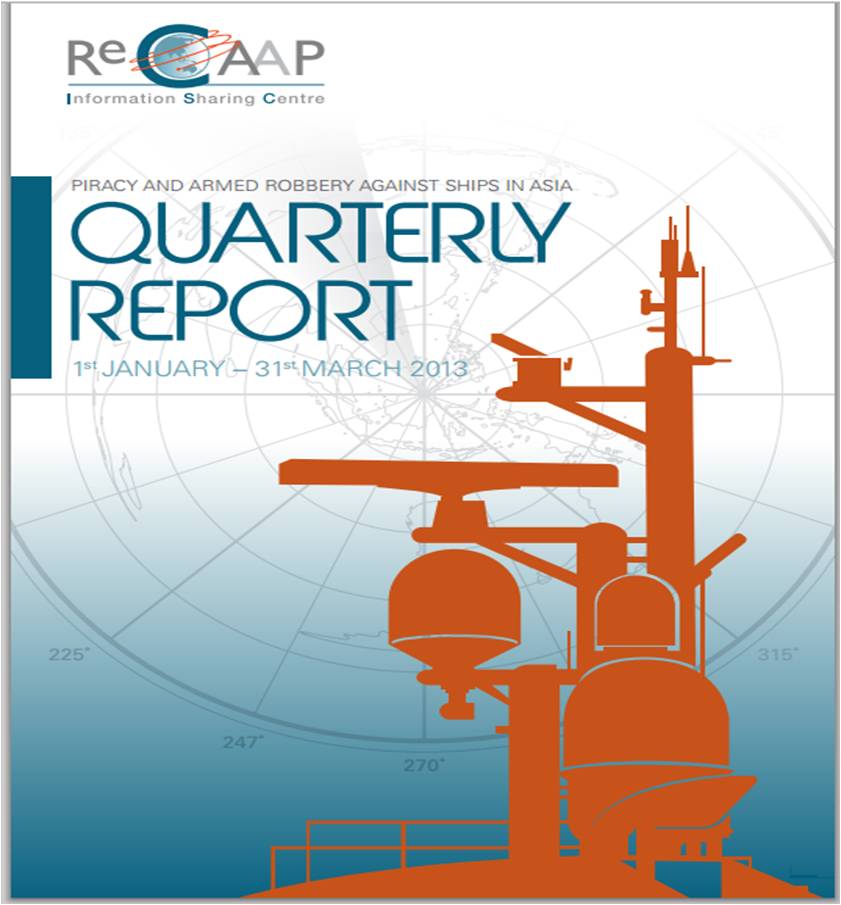ReCAAP Piracy & Armed Robbery Against Ships in Asia - Quarterly Report
Source: ReCAAP ISC
Among the 28 incidents reported in Asia during January-March 2013, three incidents involved robbers armed with guns and knives, and 10 incidents involved robbers armed with knives only. The majority (14) incidents involved robbers who were either not armed or not known if they were armed.
For the period January-March (1st quarter) of 2013, a total of 28 incidents comprising 27 actual incidents and one attempted incident were reported in Asia. Of the 27 actual incidents, five were Category 2 (moderately significant) incidents, eight were Category 3 (less significant) incidents and 14 were petty theft incidents (minimum significant). No Category 1 (very significant) incident was reported during the 1st quarter of 2013.
Compared to the same period in 2010-2012, there has been a decrease in the number of incidents and its severity. The improvement was most apparent in the South Asian region, particularly the port and anchorages in Bangladesh. For the Southeast Asian region, the improvement was most apparent in the Straits of Malacca and Singapore (SOMS) with no incidents reported there during January-March 2013 compared to the same quarter in past three years (2010-2012). However, there has been an increase in the number of incidents at some ports and anchorages, with relatively more incidents occurred during daylight hours.
Do's, Don'ts & Recommends
From the modus operandi of the robbers; and sharing of best practices by the authorities and shipping industries, the ReCAAP ISC suggests some do’s and don’ts; and recommendations to authorities, master and crew:
Do’s
- Do exercise vigilance and adopt precautionary measures when anchored at ports and anchorages, especially during hours of darkness and times of poor visibility.
- Do enhanced vigilance by the A/B watches during hours of darkness when vessels are at anchor. A visual presence has been the best deterrence against robberies.
- Do secure all items on the upper deck of vessel.
- Do report to the coastal state and port authorities all incidents (actual and attempted).
- Do adhere to precautionary measures and advisory issued by port authorities.
- Do establish the Ship’s Security Plan (SSCP) and coordinate with all crew on the implementation of SSCP.
- Do ensure controlled access and prevent unauthorized boarding by locking all access points leading inside the vessel.
- Do lock all doors and hatches of compartments when not in use.
- Do undertake vigilance rounds on upper deck especially during the hours of darkness at irregular intervals and ensure that the A/B patrol team is suitably equipped.
- Do ensure hawse pipes are covered and securely locked in place.
- Do sound alarm or whistle when see suspicious boats approaching.
Don’ts
- Don’t engage in any kind of barter trade with small boats.
- Don’t keep loose gears or unsecured items on the upper decks.
- Don’t keep the pilot ladder or Jacob ladder along the ship side.
- Don’t disregard a small incident including suspicious activities, instead should report to the authorities immediately.
Recommendations
- In general, anti-piracy measures remain the best defence against unauthorised boarding by robbers.
- Ship masters are advised to report immediately to the RCC/FP of coastal states i.a.w MSC 1/circ 1334 and undertake timely reporting to the port/maritime authorities.
- Ship masters are advised to enhance security awareness and vigilance onboard ship and encourage ship’s crew to also exercise enhanced vigilance.
- Ship masters are advised to use maximum lighting on the upper deck while at anchorage, and also to consider lighting of vulnerable areas linked to an alarm system or detection/surveillance equipment.
- Ship masters may consider greasing or installing razor wire woven through and around the anchor chain (extending up to 2 metres down the hawse pipe) while the ship is at anchor to prevent climbing.
- Be wary of the presence of small boats loitering near the ship by day. Robbers may be surveying and identifying ships that are deemed vulnerable before choosing a target to strike at night.
- In adopting preventive measures, take into consideration the safety of crew as this may hamper evacuation in the event of an emergency.
- Law enforcement agencies are required to carry out enhanced patrolling in areas of reported activities.
- Authorities to implement measures to deny usage of navigable waters for acts of robbery onboard vessels, and also to enhance coordination among all maritime authorities.
- Coastal community to conduct outreach programmes to instill awareness of the ill-effects of piracy and sea robbery; and to encourage them to report any suspicious activity to the authorities.
- Ship master and crew are advised to cooperate with the investigating authorities and share information with relevant inter-governmental agencies.
Comments by the ReCAAP ISC
While acknowledging the increase in the number of incidents at ports and anchorages, the ReCAAP ISC strongly believes that the best defence against incident at ports and anchorages is to exercise enhanced vigilance and remain alert. It is recommended that the authorities may regulate the presence of small fishing boats near ports and anchorages, which are sometimes used as covers for robbers to operate under the guise of barter trade. The presence of large number of fishing boats pose challenges to the law enforcement authorities to patrol, locate and apprehend the robbers.
Download the Full Report 
 Subscribe to our newsletter. Receive a weekly round-up of all piracy-related news.
Subscribe to our newsletter. Receive a weekly round-up of all piracy-related news.
OCEANUSLive.org
Information, Security, Safety; Shared
Submitted by Team@oceanuslive.org